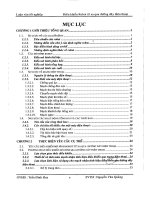Câu hỏi tiếng anh về sinh học có đáp án liên quan chủ đề DNA
Bạn đang xem bản rút gọn của tài liệu. Xem và tải ngay bản đầy đủ của tài liệu tại đây (40.1 KB, 5 trang )
United States Prevention, Pesticides, July 19, 2001
Environmental Protection And Toxic Substances
Agency (7506C)
Questions & Answers
BIOTECHNOLOGY: FINAL PLANT-
P
ESTICIDE/PLANT INCORPORATED
PROTECTANTS (PIPS) RULES
BACKGROUND
The Environmental Protection Agency (EPA) is the federal agency responsible for regulating
pesticides in the United States. Under the Federal Insecticide, Fungicide and Rodenticide Act
(FIFRA), EPA must regulate pesticides to ensure that they meet federal safety standards. The Federal
Food, Drug, and Cosmetic Act (FFDCA) requires that EPA determine safe levels of pesticide residues
in food. Plant-incorporated protectants (PIPs), the pesticidal substance and the genetic material necessary
to produce the substance, pesticides regulated under FIFRA and FFDCA.
In 1986, the federal government produced a document called the "Coordinated Framework for
Biotechnology," in which it was made clear that the regulation of pesticidal substances produced
through biotechnology would be regulated by EPA under the pesticide laws. In 1994, EPA published
proposed regulations describing EPA’s policies for plant-incorporated protectants (then called “plant-
pesticides”) under FIFRA and FFDCA. Since EPA published the proposed plant-pesticide rules in
1994, we have consulted with independent panels of scientists and solicited public comments through
supplemental notices on a variety of issues related to the rule. EPA recently issued the final versions of
these rules, which will formalize EPA’s policies for regulating plant-incorporated protectants. This
document answers common questions regarding this recent action.
List of Questions
1. What is a plant-incorporated protectant?
2. What action is EPA taking on plant-incorporated protectants?
3. Which actions proposed in 1994 were not finalized in the recently issued plant-
incorporated protectants rules ?
4. What is the difference between plant-incorporated protectants produced through
genetic engineering and those produced through conventional breeding?
5. How does the federal government regulate plant-incorporated protectants and ensure
their safe use in foods?
2
6. How will the plant-incorporated protectants rules change EPA’s current registration
process?
7. What are the benefits of plant-incorporated protectants?
8. Who did EPA consult with outside of the Agency in making this rule?
9. Will the plant-incorporated protectants rules affect the Bt reassessment?
10. Will there be an opportunity to comment?
1. What is a plant-incorporated protectant?
Plant-incorporated protectants are pesticidal substances produced and used by the living plant,
typically to protect the plant from pests, such as insects, viruses, and fungi. Plant-incorporated
protectants can occur naturally in plants, or can be introduced into plants through either the
conventional breeding of sexually compatible plants or through the techniques of modern biology (e.g.
genetic engineering). For example, the Cry proteins from Bacillus thuringensis (Bt) bacteria can be
introduced into plants, which then produce the pesticidal protein and provide the plant with resistance
to Lepidopteran insects (e.g. the European corn borer larvae). Plant-incorporated protectants have
also been referred to as plant-pesticides.
2. What action is EPA taking on plant-incorporated protectants?
EPA has issued three final rules clarifying and formalizing EPA’s framework for federal oversight of
plant-incorporated protectants. Under the final rules, most components of plant-incorporated
protectants derived from genetic engineering will be subject to FIFRA and FFDCA requirements. This
requires EPA to ensure that genetically engineered plant-incorporated protectants meet federal safety
standards by subjecting them to a rigorous registration process. EPA must also set a food tolerance for
residues of the plant-incorporated protectant (or determine on a case-by-case basis to exempt it from
the food tolerance requirement) before it can be marketed.
In our thorough scientific review of plant-incorporated protectants, the Agency has determined that plant-
incorporated protectants developed through conventional breeding pose little or no health
or environmental risks. Thus, plant-incorporated protectants derived from conventional breeding of
sexually compatible plants will be exempt from most FIFRA and FFDCA requirements with the
exception of requirements for manufacturers to report adverse effects. Certain components of the
genetic material necessary for the production of plant-incorporated protectants will also be exempt
from the requirement for a tolerance under FFDCA.
3. Which actions proposed in 1994 were not finalized in the recently issued plant-
incorporated protectants rules ?
3
EPA has indicated in a supplemental notice, which is part of the final rule package, that it intends to
consider further public comment before making final determinations on three additional exemptions
from the 1994 proposal not finalized in these rules.
• PIPs derived through genetic engineering from sexually compatible plants;
• PIPs that act primarily by affecting the plant (e.g., thicker wax cuticles); and
• PIPs based on viral coat proteins (substances that encapsulate and protect the genetic
material of certain plant viruses).
EPA has also solicited public comment on the National Academy of Sciences report, published in April
2000, entitled “Genetically Modified Pest-Protected Plants: Science and Regulation,” as it relates to
plant-incorporated protectants derived through genetic engineering.
4. What is the difference between plant-incorporated protectants produced through
genetic engineering and those produced through conventional breeding?
Conventional breeding is a method in which genes for pesticidal traits are introduced into a plant
through natural methods, such as cross-pollination. For a plant-incorporated pesticide, one would
breed a plant that produces a pesticide with a sexually compatible plant that does not possess this
property but possesses other properties of interest to the breeder, e.g., sweeter fruit. Then, out of the
offspring, the breeder would choose the offspring plant that produces the pesticide, and therefore
expresses the desired pesticidal trait, as well as producing sweeter fruit.
Genetically engineered plant-incorporated protectants are created through a process that utilizes
several different modern scientific techniques to introduce a specific pesticide-producing gene into a
plant’s DNA genetic material. For example, a desired gene that produces a desired pesticides (e.g.,
the insecticidal protein Bt from the bacterium, Bacillus thuringiensis) can be isolated from another
organism, such as a bacterium, and then inserted into a plant. The desired gene becomes part of the
plant’s DNA. The plant then expresses the incorporated gene and produces the pesticidal protein as it
would one of its own components.
5. How does the federal government regulate plant-incorporated protectants and ensure
their safe use in foods?
EPA regulates the manufacture, sale and use of pesticides, including plant-incorporated protectants, in
the United States. In addition to ensuring that registered pesticides will not pose unreasonable
adverse effects to human health and the environment when used in accordance with the label, the
Agency also assures that pesticide residues in food are safe by setting limits on the amount of a
pesticide residue that can be present on foods (called a food tolerance).
Under these rules, unless a plant-incorporated protectant falls under a legal exemption, EPA must
register it and set a food tolerance for residues of the plant-incorporated protectant (or determine on a
case-by-case basis to exempt it from the food tolerance requirement) before it can be marketed.
FDA scientists test food commodity samples to see if any substances, such as plant-incorporated
protectant residues, are present in unacceptable amounts. If contaminants are identified, FDA takes
4
corrective action. FDA also examines food labeling standards to ensure that such labels are not
misleading and to help consumers know what is in the foods they buy.
The plant itself is regulated by the United States Department of Agriculture (USDA). USDA also
regulates crops genetically engineered to be resistant to herbicides, but not the herbicide produced by
the plant. (EPA regulates any pesticide used on herbicide resistant plants).
6. How will the plant-incorporated protectants rules change EPA’s current registration
process?
The rules clarify which plant-incorporated protectants are required to be evaluated under FIFRA and
FFDCA and which plant-incorporated protectants are exempt. EPA has been reviewing and
registering plant-incorporated protectants since publication of the proposed rules and policies in 1994.
As a result, the final rules largely formalize EPA’s existing process for regulating plant-incorporated
protectants and do not change significantly EPA’s current system for scientifically evaluating a plant-
incorporated protectant.
7. What are the benefits of plant-incorporated protectants?
Plant-incorporated protectants can be a promising pest management alternative where traditional
pesticides may not be as effective and/or where other options may be more expensive. In some cases,
the use of plant-incorporated protectants could increase crop yield and/or reduce farmers' costs;
provide additional tools for integrated pest management programs, and provide other environmental
benefits. Plant-incorporated protectants can be used as a part of Integrated Pest Management and have
the potential to reduce the use of conventional pesticides, which may pose higher risk to human health
and the environment.
8. Who did EPA consult with outside of the Agency in making this rule?
EPA consulted with many agencies, organizations, and individuals in the process of finalizing the plant-
incorporated protectant rules, including FDA, USDA, the Department of Commerce, and the United
States Trade Representative. Since 1994, EPA has held workshops, requested advice from two
scientific advisory committees, the Scientific Advisory Panel (SAP) and the Biotechnology Science
Advisory Committee, testified to Congressional committees, and met with numerous groups and
individuals. The meetings of the scientific advisory committees also provided the public with
additional opportunity to comment. Many public comments were collected through the docket and
carefully considered in the process of finalizing the rules.
9. Will the plant-incorporated protectants rules affect the Bt reassessment?
No. To ensure that our biotechnology assessments reflect the latest data on health and ecological
effects, EPA is in the process of reviewing currently registered genetically modified plants expressing
Bacillus thuringensis (Bt) products. Such Bt products are categorized as plant-incorporated
protectants and are registered under FIFRA. All Bt plant-incorporated protectants have already been
assessed on a case-by-case basis; therefore, the plant-incorporated protectant rules will not affect
current registration of Bt products.
5
10. Will there be an opportunity to comment?
In a supplemental notice accompanying the final rule package, EPA is soliciting additional information
and public comment on issues from the 1994 proposal not finalized in these rules. In addition, we are
opening a public comment period on the NAS report, published in April 2000, entitled “Genetically
Modified Pest-Protected Plants: Science and Regulation,” as it relates to plant-incorporated protectants
derived through genetic engineering. EPA plans to make final determinations regarding additional
rulemakings within nine to twelve months after the close of the comment period. Currently, the
comment period is set at 30 days. Please send your comments to the public docket at
US EPA
OPP Public Regulatory Docket (7502C)
Docket No. OPP-300369B
Ariel Rios Building
1200 Pennsylvania Ave. NW
Washington, DC 20460.
For more information on EPA’s biotechnology program, you may visit our web site at
www.epa.gov/pesticides/biopesticides.









